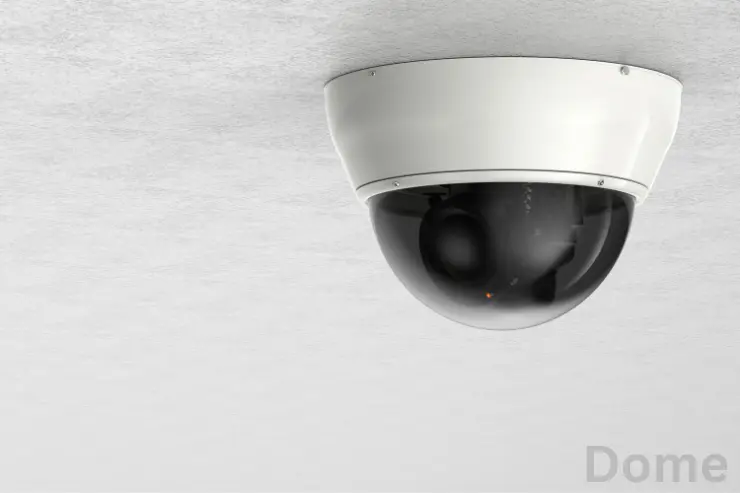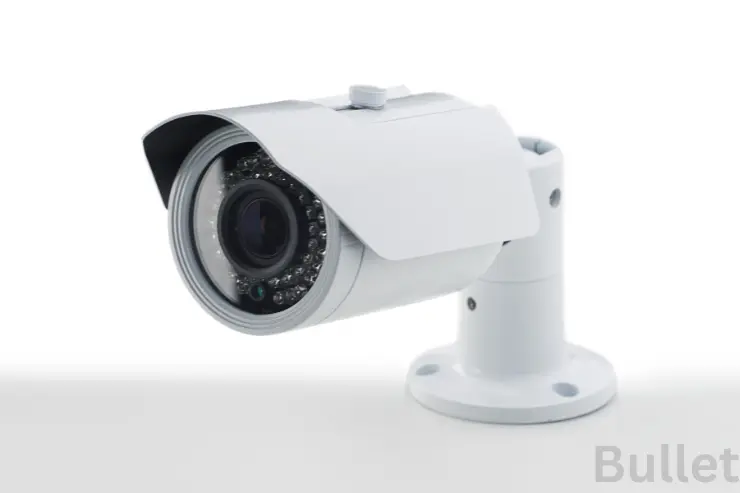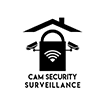Dome Vs Bullet Cameras: Which One Is Right For Your Business?
Ensuring building security, investing in preventive measures is crucial. Academic studies, like those from the UNC Department of Criminal Justice, show that up to 50% of potential burglars are deterred by visible security cameras. A well-integrated video system can speed up incident response times. It helps businesses implement effective security measures. This boosts overall efficiency.
Choosing the right security camera for your business can be complex. Many types to consider, from panoramic 360-degree cameras to pan-tilt-zoom cameras. The two main categories are dome and bullet cameras. Dome security cameras offer a wide angle field of view, making them ideal for general monitoring. They also tend to be less prone to dust and other debris blocking the lens.
However, they’re not as discreet as bullet models and robbers may be able to tell which direction the camera is facing. They’re also harder to reposition than a bullet camera.
What are dome-style security cameras
In the security camera industry, dome cameras are CCTV devices inside a clear enclosure shaped like a dome. Typically, they are ceiling mounted but can also be installed on walls.
They differ from bullet cameras in that their rounded shape makes them less conspicuous and more discreet for many use cases.
Additionally, they can be positioned so that onlookers cannot determine the direction of the camera lens from a distance, an effective deterrent for crime and vandalism.

Unlike traditional CCTV cameras, dome cameras often include built-in infrared LEDs and progressive CMOS sensors to provide excellent low-light performance. Additionally, their dome encasing offers more protection for the lens and camera components from harsh environmental conditions like dust and debris, enhancing their durability.
The dome shape also makes the camera easier to reposition without removing or destroying the casing, making them more resistant to tampering and vandalism. However, dome cameras require more maintenance since dirt can collect easily in the dome cover. Also, the dome shape may not be appropriate for locations that need to protect the camera against wind or rain.
What are Bullet-style security cameras?
With so many options in every aspect of life, it can be hard to know where to begin. With options ranging from video quality to weather protections, storage options and more, picking out security cameras can seem overwhelming.
Luckily, in most cases, the decision comes down to one of two main choices. The choice between dome and bullet cameras is much like Coke or Pepsi – one may be preferable in certain situations, while the other will work best in others.
As the name suggests, bullet security cameras are cylindrical in shape. They are often protected by a casing that protects against dust, water and other environmental hazards. This protective enclosure can also help to make the camera less intrusive.

They can be used indoors or outdoors, with a variety of different mounting options available. They are known for their long-distance viewing capability, which makes them ideal for monitoring large areas or capturing license plates from far away. Their visibility can act as a deterrent, especially when they are installed in high-crime areas or near points of entry.
The Basic Differences: Bullet vs Dome Cameras
Deciding on the style of security camera you use for your business may seem like a minor detail, but it could make all the difference in meeting your security needs. With options for weather protections, storage capacities, night vision capabilities, and more, there’s a lot to take into consideration when it comes time to select the perfect model.
Depending on your location, desired visibility, and coverage requirements, selecting the right security camera for your business could require you to choose between dome and bullet cameras. Both offer unique advantages that you may not have considered.
Dome cameras have a circular or half-sphere shape that holds the lens, making them ideal for indoor and outdoor surveillance. They’re also easy to install, with some models supporting Power over Ethernet (POE) to reduce installation costs and complexity. However, they’re slightly more susceptible to glare than other security camera types as they lack anything obscuring the lens, and may require more frequent maintenance to keep their clear casing clean.
Discreteness and design
Dome cameras can offer a more sweeping field of view than bullet models, as they can be mounted on ceilings for a broader vantage point. Similarly, they can incorporate pan-tilt-zoom (PTZ) capabilities that allow for more detailed monitoring.
With their more discreet appearance and design, dome cameras are ideal for indoor spaces and situations where a less visible security presence is required. They can also act as a deterrent to criminals who might be able to spot a camera.
However, they don’t provide the same long-range clarity that bullet cameras do. This makes them more suitable for applications where details such as license plates or faces need to be observed over a greater distance, such as in parking lots, garages and roadways.
The clear casing of dome cameras also attracts more dust and fingerprints, so they need to be cleaned more regularly. They can also be more vulnerable to vandalism and need to be positioned well away from areas that could become a target for bird nests or spider webs. The right choice ultimately depends on your unique surveillance camera needs.
Dome vs Bullet Security Cameras: Use cases
There are a number of use cases for both dome and bullet security cameras, depending on the property’s surveillance needs and aesthetic preferences. For example, a company might choose bullet cameras to act as a visible deterrent against intruders, while a hotel might prefer dome cameras for discreet monitoring of guest rooms and common areas.
Perimeter Protection
For monitoring large open spaces like the perimeter of a commercial building, large parking lots, or a property’s garden, bullet-style cameras are often more practical. Both dome and bullet cameras can be mounted outside and function well in low light. However, bullet cameras excel in long-range capabilities, making them better suited for low light security. For extreme temperature conditions, both types can be equipped to withstand harsh outdoor elements.
Building Access
To monitor access points around a building, dome cameras are typically more beneficial. Dome cameras provide a wider field of view, ideal for overseeing large open spaces.
Commercial Property Interiors
Dome and bullet cameras can both be effective indoors, but the choice depends on the specific needs of the property.
- Dome Cameras: Ideal for wide areas like retail store aisles and crowded spaces. They offer a wide viewing angle and can track moving targets.
- Bullet Cameras: Better for monitoring specific areas where targets are likely to remain stationary, such as loading docks, private walkways, or high-value item displays.
Commercial Property Exteriors
For the exterior of a commercial property, bullet cameras are usually preferred due to their visible deterrent effect. For commercial security camera installation bullet cameras are ideal for parking lots, gates, and exterior doors. Their narrower field of vision provides clearer images of vehicles and individuals entering and leaving the property.
The elongated shape of the bullet camera makes it easy for onlookers to discern which direction the camera is pointing in, making it more susceptible to vandalism and tampering. It also takes more effort to adjust the view, as it must be taken down and remounted to change the field of vision.
On other hand dome camera’s sleek, rounded housing can be more discreet and less of a target for tampering and vandalism. For elevator security cameras, dome cameras are ideal due to their compact size and robust surveillance capabilities, ensuring comprehensive security coverage.
These cameras are typically positioned in a high spot where they’re less accessible, and some dome cameras even come with features like tamper detection alarms to help protect against this type of damage. It’s important to consult with a professional before choosing which type of camera is best for your property’s needs.
Dome Cameras vs Bullet Cameras: Which is Better?
While neither dome or bullet cameras are inherently better or worse than the other, each has its strengths depending on the situation. Choosing the right type can help you address specific needs effectively.
1. Coverage Area:
Bullet cameras are better for long-range applications.
Dome cameras cover wide fields of view.
2. Environmental Considerations:
Both types can be installed outdoors.
Bullet cameras may be more affected by environmental elements like spider webs and bird nests, which can disrupt the viewing angle.
Dome cameras have a clear casing that requires regular cleaning for optimal image quality.
3. Mobility:
Dome cameras are more suitable for permanent installations.
Bullet cameras are easier to adjust and reposition.
4. Visual Deterrent:
Bullet cameras are more visible, making them a better visual deterrent for potential intruders.
Consider these factors to determine which type of camera best fits your needs.
Dome vs. Bullet Camera: Which is Easier to Install?
When it comes to installation, bullet cameras are usually easier to set up than dome cameras.
Bullet Cameras
Simple Installation: Bullet cameras have a straightforward mounting process.
Easy Adjustments: They are easy to adjust once installed, allowing you to quickly change the camera’s angle or direction.
Accessible: The design of bullet cameras makes them more accessible for maintenance and cleaning.
Dome Cameras
Complex Installation: Dome cameras can be more challenging to install due to their compact and enclosed design.
Precision Required: Proper installation requires precision to ensure the camera covers the desired area.
Less Accessible: Adjusting and maintaining dome cameras can be trickier because of their design.
If you’re looking for a camera that’s quick and easy to install, a bullet camera might be the better choice. However, dome cameras, while a bit more complex to set up, offer a sleek design and are less noticeable, which can be beneficial for certain security needs.
Bottom Line
When enhancing your business’s physical security, choosing between bullet and dome cameras significantly impacts your return on investment. It’s crucial to carefully consider installation details and weigh the pros and cons of each camera type to determine the best option for your needs.
As a rule of thumb, bullet cameras are ideal for capturing long-range footage and serve as a visual deterrent with their prominent lens. However, their narrow angle of view may limit effectiveness in smaller or confined spaces. On the other hand, dome cameras are well-suited for wide areas such as office buildings and commercial interiors, though adjusting them after installation can be more challenging.
If you’re still deliberating between dome and bullet cameras, remember that selecting a trusted security camera provider offering reliable products and professional management software ensures optimal performance of your video security system.
CONTACT NOW!
Contact us now to get a free consultation and save big by installing security cameras on your property.
Click Here